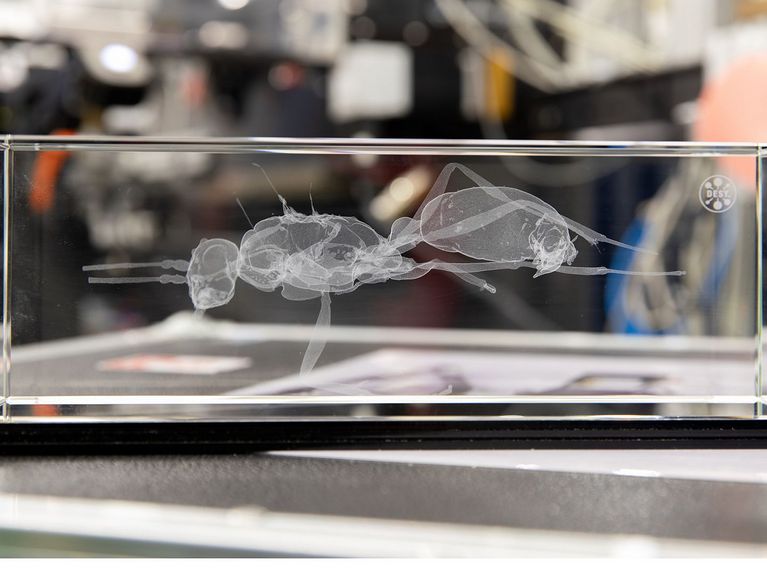Micro-computed tomography
Ants in the synchrotron

Enlarged image of extinct prehistoric ant in a glass block. Credit: DESY, Marta Mayer
In a million-year-old piece of amber, researchers have identified a prehistoric ant as a genus and species in its own right. This was achieved with the help of the PETRA III X-ray light source in Hamburg. The new species was therefore named after the research centers involved.
The †Desyopone hereon male had to wait 16 million years for his big appearance. Maybe even 23 million, but what do a few million years matter? The animal was discovered in amber from Ethiopia. In a joint effort, scientists from the Universities of Jena and Rennes, France, as well as from DESY and the Helmholtz Center Hereon, have put the ant in perspective, and thus rewritten a bit of the evolutionary history of its species.
The amber comes from the only occurrence in Africa, more precisely in Ethiopia, where insects are found in inclusion fossils. There are very few insect fossils on the continent of Africa, so the find was of great scientific value to Brendon E. Boudinot from the start. He works at the Institute of Zoology and Evolutionary Research at Friedrich Schiller University in Jena, Germany, conducting research on the anatomy, development, paleontology and evolutionary morphology of ants and insects in general, and says, "The goal of my work is to document, systematize and explain the biological diversity of life across developmental and geological time." His love of ants has lasted for many years and began in the here and now: "Ants are special to me because I've spent about two decades trying to understand them from their original habitats to the lab and more recently through their fossil record." From the forest floor to the synchrotron? "The µ-CT has completely changed the way I see them, living or extinct."
Brilliant light for details in amber
The PETRA III light source at DESY (German Electron Synchrotron) was used for the new investigations. Scientists from a wide range of disciplines are offered excellent experimental opportunities here. Fast electrons are sent on looping paths in the facility. As a result, they emit strongly focused X-ray light. The X-rays from PETRA III are up to 5,000 times finer than a human hair and allow the examination of extremely small samples; tiny crystals of proteins as well as nanocrystals, materials or even fossils. The ant researchers can thus gain a non-destructive insight into the valuable fossils. At the measuring station operated by the Helmholtz Center Hereon at PETRA II it is possible to record images for many different angles by means of micro-computed tomography, and thus to reconstruct two-dimensional layers or sections through the object. If these layers are stacked, the structure can be displayed in three dimensions, which can be used to precisely reconstruct the anatomy.
Martin Müller, head of the Institute for Materials Physics at the Helmholtz Center Hereon, and Christian Schroer, senior scientist at DESY's X-ray source PETRA III, accept a model of the newly identified primordial ant from Brendon Boudinot, lead author of the paper from Friedrich Schiller University Jena, and co-author Jörg Hammel, scientist at the Hereon measurement station at PETRA III, where the studies took place. (f.l.t.r.). Credit: DESY, Marta Mayer
That the millions and millions of years old amber - accurately dated based on spores and pollen in the resin - is something special, was already apparent to the researchers in advance. Many weeks, months and years were spent preparing and polishing the amber, comparing findings and formulating new hypotheses. Examinations with a standard light microscope made it clear that these ants were highly unusual. It proved difficult to assign the animal to a genus. When the researchers combined their comparisons with known animals, recent findings from other studies and the high-resolution 3D scans, they realized something amazing: "This fossil is not a known animal!" says Brendon Boudinot. "It is closely related to, but cannot be classified in, the small genus of subterranean and predatory ants called Cryptopone." The consequence was to recognize the fossil as a new genus and new species †Desyopone hereon, which offers some late glory for the individual small ant, but is an important step for research: "We found that the standard criteria for identifying fossil ants need a fundamental revision."
Ultimately, the identification of the new species and genus was only possible through a combination of extensive phenotype data from scans and recent findings from genomic analyses of living ants. Genomic and phenomic data illuminated the problem of this fossil in a reciprocal way. "It is clear to us that this will become increasingly common as genomics and phenomics are used together to solve biological problems," affirms Brendon Boudinot. "µ-CT has thus become a key tool for hypothesis testing in the 21st century."
Readers comments